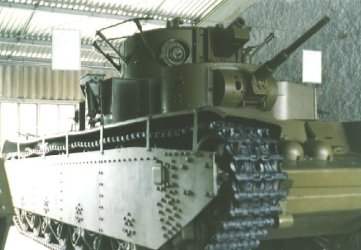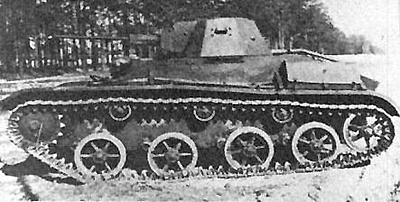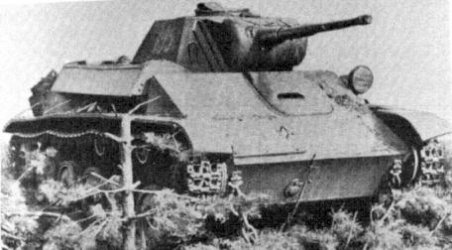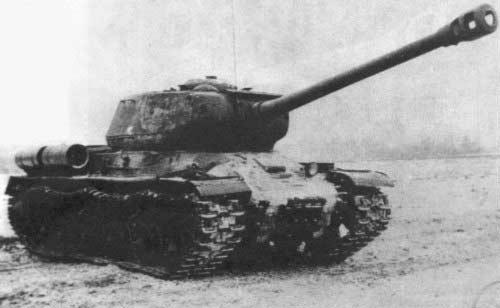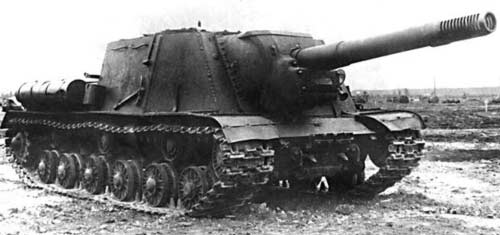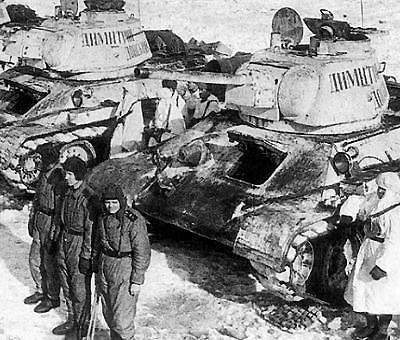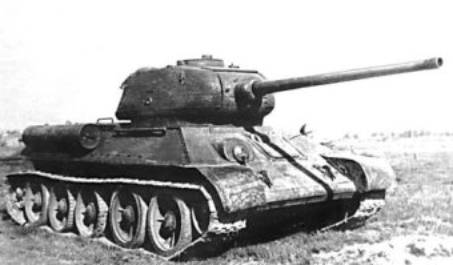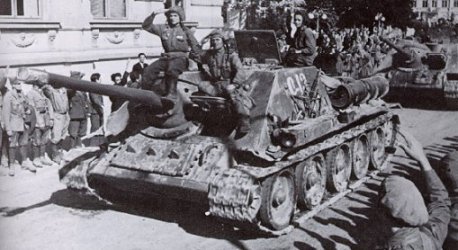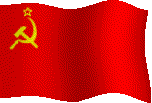
The T35 features in the Panzer Front mission, "Strike Army". It has the call sign of Star. Unfortunately it is not a playable tank.
The T35 is unique, in that is the only five turreted tank to enter serial production. It's role was to break through enemy strongpoints. The main turret was armed with a short barrelled 76.2mm gun, and also three DT machine guns. The two medium sized turrets were armed with 45mm anti tank guns, and a DT machine gun each. The two small turrets housed a single DT machine gun each.
The T35 looked very impressive, but it suffered from mechanical problems, and the commander found it all but impossible to direct the fire of five turrets, give the driver orders, and keep up with the tactical conditions of the battlefield.
Weight=50 tonnes. Crew=11. Length=9.72 metres. Width=3.2 metres. Height= 3.4 metres.
The T60 & T70 light tanks
The T60 features in the German mission, "Vitebsk". Again this is not a playable tank. The T70 is a playable tank from Panzer Front Bis.
The T60 was an infantry support tank, it's main armament was a 20mm automatic cannon. This was hopelessly inadequate against armoured vehicles. Despite it's small size and low weight the T60 was not particularly fast, it's GAZ engine giving a top road speed of 45Km/h.
This was slower than the much superior T34, and even later model KV1 heavy tanks. It was replaced in 1942 by the slightly larger T70.
The T70 was upgunned with a 45mm gun, but retained many of the problems of the T60.
T60:Weight=6.4 tonnes. Crew=2. Length=4.1 metres. Width=2.3 metres. Height=1.74 metres.
T70:Weight=9.2 tonnes. Crew=2. Length=4.29 metres. Width=2.32 metres. Height =2.04 metres.
The KV1 Heavy Tank
The KV(Klimenti Voroshilov)1 features in the Gaytolova, Swtch Ocktjarbirsk, Hill 220.5, Sinjavino and Vitebsk missions. It was the main Soviet heavy tank until replaced by the IS(Ioseph Stalin) series, which were improved variants of the KV1.
Like other Soviet vehicles it's design was simple and robust. It was powered by a V2K 4 stroke diesel engine developing 500 hp and had a top road speed of 22 mph. Armament consisted of a ZIS-5 76.2mm main gun of 41.5 calibres in length with stowage for 98 rounds of ammunition and three 7.62mm DT machinguns. As well as the usual hull mount and coaxial machineguns, Soviet heavy tanks mounted a third machinegun in the rear of the turret.
The excellent armoured protection of the KV1 was proof against most German tank guns during the first year of the Russo-German War. With the introduction of the Tiger and the upgunning of other panzers in 1942 the KV1's reign of near invulnerability ended. Although superceded, the KV1 remained in service until the end of the war with one battalion participating in the battle of Berlin.
The two variants of KV1 in the game are the 1940 model, which can be distinguished by its angular turret with extra armour plates bolted on and its rounded hull rear; and the 1942 model with a thicker, cast turret and flat rear plating.
Weight= 46 tonnes Crew:=5 standard, 4 typical .Length= 6.8 metres. Width=3.32 metres. Height= 2.71 metres.
The IS2 and IS2M Heavy Tanks
The IS (Iosef Stalin) 2 tanks feature in the Sachsendorf and Berlin missions, and in the Seelow mission in PF Bis.
They were first issued to Guards Heavy Tank Regiments in April 1944. The series was really a re-design of the earlier KV1. They were powered by the ubiquitous V2 multifuel engines, with aroad speed of 38 km per hour.. Armament consisted of an A19 122mm gun of 43 callibres in length, with stowage for 28 rounds of ammunition. The secondary armament was two DT machine guns. There was no hull mounted machine gun, but the co-axial and rear trret machine guns were retained
The IS hull featured sloped armour and a larger turret to mount a heavier gun than earlier Soviet heavy tanks. Careful redesign of the KV hull had produced improved armour protection, without badly effecting weight. In fact the weight and size of the IS2 was mch closer to that of the German Panther, than that of the Tiger heavy tanks. The improved interior layout and their effectiveness against German armour made the IS tanks popular with their crews.
Their main drawback was a slow rate of fire, which was improved slightly by the IS2M which featured an improved breach design for the main gun.
Weight=46 tonnes. Crew=4. Length=9.9 metres. Width= 3.1 metres. Height= 2.73 metres.
The ISU 152 Tank Destroyer.
The ISU 152 features in the Berlin mission of Panzer Front.
It replaced the earlier SU152, the difference being that the Su was based on a KV1 chassis, and the ISU, on that of an IS2.
These vehicles were designed in response to the new German tanks, and tank guns of 1942. They used the same reliable V2 engines as most other Soviet tanks, and had a top road speed of 35 km per hour..
The main armament was an ML 152mm gun of 32 callibres in length, with stowage for 20 rounds of ammunition. Sometimes a DT machine gun was monted on the roof for anti aircraft, and anti infantry use.
The Soviet tank destroyers were rapidly designed and produced in expectation of the German summer offensives of 1943. (The SU152 prototype being designed and manufactured in only 25 days!)
A casemate mounted on a proven hull allowed the largest possible main gun to be carried. The first unit of 12 SU152's acounted for 12 Tigers and 8 Elefant's over 3 weeks of the Kursk-Orel fighting, earning them the nickname of "Zvierboi" (big game hunter)
Their heavy calibre gun was devastating against armour, and it's huge high explosive rond made it very welcome in the infantry support role. The ISU 152 was used in a close support role from it's introduction in 1944 through to the battle for Berlin, and then in defeating the Japanese army in Manchuria.
Weight=46 tonnes Crew=5 Length= 9.18 metres. Width= 3.07 metres Height= 2.48 metres.
The T34 tank
"The best tank in the world" That's how General Von Runstedt described the T-34. Put into production in September 1940 this tank would haunt the German army.
Some 33,800 T-34's were built. This includes 1170 that had flamethrowers in place of the bow machine gun. The models build include the 1940, 1941, 1942, and 1943.
It's design was simple and easy design to build (about 40 hours). The 1940 model mounted a L-11 76mm gun with 77 rounds. 1941 and later models carried the improved F-32 76mm gun. All carried 1 bow mounted 7.62mm DT machine gun and 1 Coaxial DT machine gun. It's frontal sloped armour was proof aganist any of the early German tanks. It was only at the arrival of the Tiger I and Panther tanks, that the Germans had a tank that could kill the T-34 at ranges greater then 300m . It's V-2 12-cylinder diesel engine drove the tank at speeds up to 53Km/h and provided the T-34 with a range of 300 - 400 Km depending on the model. The T-34 was used right up to the end of the war.
Weight= 26.5 tonnes. Crew= 4. Length = 5.92metres. Width= 3 metres. Height = 2.41metres.
T34/85
The T34/85 appears in the Sachsendorf and Berlin missions.
It was the final variant of the T34 series to enter service and was issued to tank regiments from August 1944.
Using the same hull, engine and power train as earlier T34s, it featured improved running gear and a much larger and better laid out turret. Armament consisted of a D-5T 85mm main gun of 51 calibres in length with stowage for 56 rounds of ammunition and two 7.62mm DT machineguns.
The turret was spacious and well armoured. Speed and cross country performance were excellent. The 85mm gun was the largest weapon which could be turret mounted on a T34. Hull mounted weapons could, of course, be larger and were utilised in the SU100 and SU122. More than 19,000 T34/85s were built and after the Second World War went on to serve in Korea, the Middle East and even Vietnam.
Weight: 35t
The Su85 Tank Destroyer.
The SU (Samokhodnaya Ustanovka) 85 features in the Krasnoe Sero mission. It was the Soviet Unions first fully enclosed tank Soviet destroyer, and retained all the advantages of the T34. It was simple and quick to build, reliable, and had adequate protection due its excellent ballistic shape.
It was designed in response to the new German tanks and tank guns introduced in 1942. It used the same V-2 engine as the T34, upon whose design it was built, and had a top road speed of 54 km/h. Armament consisted of a D-5T 85mm gun of 51 calibres in length with stowage for 48 rounds of ammunition.
Initially designed as a stop gap measure to provide an armoured vehicle mounting a superior gun to the now inadequate 76.2mm weapon of the T34 and KV1, the SU85 made its battlefield debut in the Kursk-Orel battles of the summer of 1943. Along with the SU152 it proved to be a very effective tank destroyer. Its advantage over the SU152 was its superb speed and ground crossing capability. The SU85 was in turn superceded by the SU100 which was simply an SU85 reworked to carry the BS-3 100mm 55 calibre gun. Although overtaken in its tank destroyer role the SU85 remained in service until war's end providing close support to infantry units and could still deal with most panzers if it had to.
Weight=35 tons. Crew= 4. Length= 8.15 metres.
Width= 3 metres. Height= 2.45 metres.
NKL-26
The NKL-26 features in the Neva mission of panzer front bis, and is playable in the construction mode.
The NKL-26 is also known as the Aerosan, or aerosled. It was designed for quick transportation over snow, and larger variants could tow small artillery pieces. The model 26 was the only armoured variant of the war, but was still largely made of wood!
The large propellor and engine were surplus aircraft parts, and delivered a top speed of around 50 miles per hour.
The NKL-26 was armed with one DT machine gun which was mounted on an armoured cupola on the vehicle roof, and was operated by the commander.
The four skis were also made from wood, and as such were light, flexible, and easy to replace.
The vehicle was useful for reconnaisance and scouting in the expanse of a Russian winter, but was very vulnerable to even small arms fire,and battlefield debris could not be easliy traversed.
